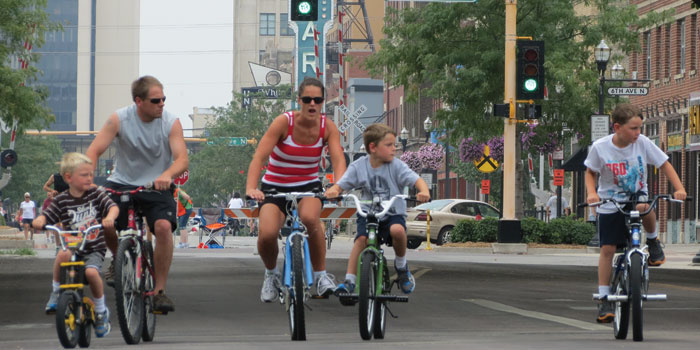
For two Sundays every summer, a three-mile loop between downtown Fargo, North Dakota and nearby Moorhead, Minnesota is transformed. The open streets event StreetsAlive draws between 6,000 and 8,000 people -- on bikes, sneakers and rollerblades -- into the space that is normally occupied by cars.
The event began as a healthy living initiative, with sponsorship from Blue Cross of Minnesota, managed by the Dakota Medical Foundation. But organizers say that as it has grown in popularity over the last three years, the event has evolved into something potentially transformative.
Local leaders are trying to use StreetsAlive to educate the public about the benefits of non-motorized transportation, and it seems to be working. Last year's theme was "Life After Cars." Embarking on a regional planning process, local officials reported high levels of support for amenities like bike lanes.
"People see this as a fun event, and we see it as the beginning of a conversation about better transportation,” Jill Chamberlain, a funding officer from Blue Cross Minnesota, told researchers at MIT recently.

"Placemaking" activities like this one -- defined as the "deliberate shaping of an environment to facilitate social interaction and improve a community’s quality of life" -- have important benefits that last far beyond when the street barriers are packed up and traffic returns, according to a new report by Susan Silberberg and her research team at MIT. According to their report -- Places in the Making: How Placemaking Builds Places and Communities -- the actual process of placemaking can be even more important than the physical outcome.
Open streets events, Park(ing) Day demonstrations, or a Better Block effort -- these projects build social capital and empower citizens to drive change in their communities. And that can have a powerful impact long after the project's completion.
"The act of advocating for change, questioning regulations, finding funding, and mobilizing others to contribute their voices engages communities -- and in engaging, leaves these communities better for it," Silberberg writes.
Rather than focusing solely on the physical outcome of a placemaking project -- a park design, for example -- Silberberg and her team say it's important to recognize that these projects tend to be ongoing. Public spaces are never really "finished" anyway, they say, but rely on ongoing adaptation and maintenance from the community.
Another case study examined the "Intersection Repair" project in Cleveland. This process began with a series of meetings and a design party, involving community leaders and neighborhood residents.
One of the outcomes was the resign of Newark Alley, a dark, overgrown passage in the city's working-class Stockyards Neighborhood. An elderly neighborhood resident remembered when the area was home to a stream and orchard. That memory inspired the final design, which is painted to look like a river.
The process also included mural painting and improvements across the neighborhood. One of the benches was painted with an inspirational message that gets to the heart of what's at stake here: “You don’t have to move to live in a better neighborhood."
In this sense, placemaking projects offer a welcome contrast to the planning dynamics of previous decades, which were characterized by top-down mega-projects led by impenetrable bureaucracies. The newer approach to planning -- of which placemaking is a part -- is inherently more democratic, more immediate and smaller-scale.





